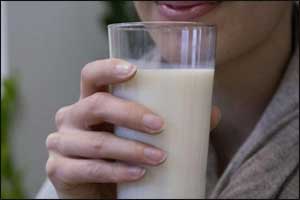- Home
- Editorial
- News
- Practice Guidelines
- Anesthesiology Guidelines
- Cancer Guidelines
- Cardiac Sciences Guidelines
- Critical Care Guidelines
- Dentistry Guidelines
- Dermatology Guidelines
- Diabetes and Endo Guidelines
- Diagnostics Guidelines
- ENT Guidelines
- Featured Practice Guidelines
- Gastroenterology Guidelines
- Geriatrics Guidelines
- Medicine Guidelines
- Nephrology Guidelines
- Neurosciences Guidelines
- Obs and Gynae Guidelines
- Ophthalmology Guidelines
- Orthopaedics Guidelines
- Paediatrics Guidelines
- Psychiatry Guidelines
- Pulmonology Guidelines
- Radiology Guidelines
- Surgery Guidelines
- Urology Guidelines
Vitamin-A-enriched fodder is the key to protection against milk allergy

The incidence of milk allergy is about three to five percent in European children and more rarely in adults. This disease is different from lactose intolerance and it is caused by distinct immune response of the immune system itself against the milk proteins. In a study by researchers of interuniversity Messerli Research Institute of Vetmeduni Vienna, Meduni Vienna and the University of Vienna it has been found that Vitamin-A-enriched fodder is the key to protection against milk allergy and Loading with retinoic acid transforms a potential milk allergen into a milk tolerogen.
A study of the interuniversity Messerli Research Institute of Vetmeduni Vienna, Meduni Vienna and the University of Vienna has now shown that the components of the cow's milk itself can help to prevent this reaction. The key is that the milk protein beta-lactoglobulin, a relevant agent for allergic reactions, literally "pockets" a metabolite of vitamin A called retinoic acid. This, however, would require cows to receive a sufficient supply of this vitamin, for example, through an abundance of green fodder.
If infants become allergic to cow's milk, their bodies produce so-called Th2 lymphocytes. These are specialized immune cells that produce antibodies to fight milk proteins as part of the immune system. One of the most important of these so-called milk allergens is the protein Bos d 5. Also known as beta-lactoglobulin, it is part of a family of proteins known as the lipocalins. "This special protein family is characterized by molecular pockets that can take in small molecules like retinoic acid, which is a metabolite of vitamin A," explains first author Karin Hufnagl.
"Our study showed that an 'empty' milk protein supports the activation of Th2 lymphocytes and so initiates an allergic chain reaction," says Hufnagl. However, if it, so to speak, pockets the retinoic acid, then the immune cells react moderately, without an allergic immune reaction. "An adequate loading of the milk protein could thus prevent that small children or even adults become sensitized and express a milk allergy," summarizes study leader Erika Jensen-Jarolim.
No artificial supplements: vitamin-A-enriched fodder during milk production is the key
Milk, and above all cow's milk, is an essential food product for most people. For allergy patients, however, it poses a risk. Besides causing a swelling of the mouth or the mucous membranes, other symptoms can include diarrhoea or aggravated atopic dermatitis, and, in rare cases, can even induce an allergic shock. In addition, a cow's milk allergy carries the risk of other allergic diseases, such as atopic dermatitis or allergic asthma. "A sufficient supply of vitamin A to the milk producers, i.e. the cows, could counteract this effect in which a harmless food protein is converted into a milk allergen," says Hufnagl. It is uncertain, however, whether the positive effect of natural vitamin A shown in the study can also be achieved through dietary supplements. "Artificial supplementation of a diet with vitamins may not achieve the same effect as natural agents and will likely result in inadequate loading of the milk allergen. It is therefore necessary to supply vitamin A to an appropriate extent already during the keeping or feeding of the animals. This can be achieved, for example, by increasing the supply of green fodder. Corresponding follow-up studies must still be carried out, however," says Hufnagl.

Disclaimer: This site is primarily intended for healthcare professionals. Any content/information on this website does not replace the advice of medical and/or health professionals and should not be construed as medical/diagnostic advice/endorsement or prescription. Use of this site is subject to our terms of use, privacy policy, advertisement policy. © 2020 Minerva Medical Treatment Pvt Ltd